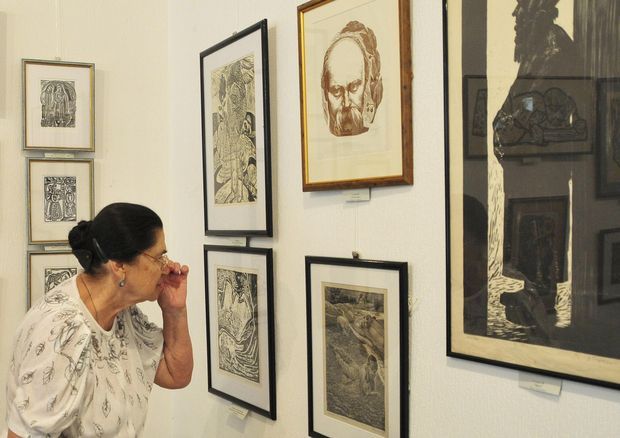From the past till present day
The Museum of Kyiv History launches an exhibit of Sixtier artists, “The Spark”
The exposition includes nearly a hundred of works of over 30 artists, provided by the recently opened Museum of Sixtier Movement. Those are not all representatives of this artistic resistance movement even close, because to highlight the activity of the Sixtiers, much more halls and exhibition venues will be needed. Writer and philosopher Yevhen Sverstiuk; People’s Artist of Ukraine, academician of the National Academy of Ukraine Vasyl Perevalsky; Merited Artist of Ukraine, winner of the National Taras Shevchenko Prize and Vasyl Stus Prize Liudmyla Semykina; Merited Artist of Ukraine, winner of Vasyl Stus Prize Halyna Sevruk; poet, playwright, state and public figure Ivan Drach gave speeches at the opening ceremony. These artists are directly connected with the Sixtier movement. With a note of nostalgia they recalled the 1960s, when the groundwork of real independence of Ukraine was being laid. Research fellow with the Museum of Sixtier Movement Olena Lozynska emphasized the importance of the national program of patriotic education of the youth, especially based on the works of the Sixtiers.
Ukrainian Sixtier Movement was a special phenomenon in socio-cultural and sociopolitical life of Ukraine in the second half of the 20th century, which, like a primrose, developed in the heart of the totalitarian system during Khrushchev’s Thaw. The movement of the Sixtiers started with the creation of a Club of Creative Youth “Contemporary” in Kyiv at the initiative of Les Taniuk, joined by the educated people, the intellectual elite: writers, poets, opinion journalists, literary critics, artists, cinema artists, theater workers, et al. As a motto they took Taras Shevchenko’s words: “I will glorify the mute slaves! I will put the word to guard them.”
Gradually the movement spread all over Ukraine and won broad popularity. The Ukrainian artists showed a high level of national awareness, freedom of thinking, innovation; they sought to break away with the stifling atmosphere of the ideological Soviet time. By their creative work they declared that there is another system of values connected with the cultural and historical heritage of our people, and their works became a bright spark, a light spot in the background of hackneyed-formal art of socialist realism.
The artists’ search for new ways of expression, new shape and content, developing of their own creative manner which would be adequate to their world outlook were declared ideologically harmful, and many artists were deprived of the possibility to take part in the exhibits, even to create, and some of them were convicted and sent to the camps. The repressed included Opanas Zalyvakha among others; Alla Horska was brutally killed in the early 1970s. It is worth recalling the destruction of stained-glass work Shevchenko. Mother in the lobby of the Kyiv-based Taras Shevchenko National University which was created by Horska in association with Zalyvakha, Semykina, Sevruk, and Zubchenko, which was proof of suppression of any attempts to think differently, go against the demands of socialist realism and ideological instruction.
The exhibit displays the works of different kinds of art, genres, and styles, which go chronologically beyond the 1960s. So, one can see the portraits by Alla Horska, Viktor Zaretsky, Halyna Sevruk; still lifes by Ivan Honchar; landscapes by Halyna Zubchenko, Hryhorii Pryshedko, which were executed in various techniques; costumes by Liudmyla Semykina; illustrations by Sofia Karaffa-Korbut, Heorhii Yakutovych; graphic works by Vasyl Perevalsky; graphic works and decorative paintings by Liubov Panchenko, and many other original and highly artistic works. The genre works by Viktor Zaretsky attract particular attention, with To Commemorate the Sixtiers being especially distinguished, as well as Blue Bird by Halyna Sevruk. The visitors will be able to familiarize themselves with the literary legacy of the Sixtiers, in particular, the books by Viacheslav Chornovil, Vasyl Lozovy, Les Taniuk, and works about the Sixtiers by Mykola Plakhotniuk and Roman Korohodsky.
The exhibit will be open till August 28.
Newspaper output №:
№47, (2014)Section
Culture





